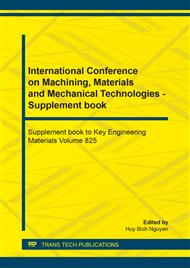[1]
S. Haeberle and R. Zengerle, Microfluidic platforms for lab-on-a-chip applications, Lab Chip 7 (2007) 1094-1110.
DOI: 10.1039/b706364b
Google Scholar
[2]
F. Yu, L. Ai, W. Dai, N. Rozengurt, H. Yu, T. K. Hsiai, MEMS thermal sensors to detect changes in heat transfer in the pre-atherosclerotic regions of fat-fed New Zealand white rabbits, Ann Biomed Eng. 39 (2012) 1736-1744.
DOI: 10.1007/s10439-011-0283-8
Google Scholar
[3]
L. Wang, K. Sun, X. Hu, G. Li, Q. Jin, J. Zhao, A centrifugal microfluidic device for screening protein crystallization conditions by vapor diffusion, Sensors and Actuators B: Chemical 219 (2015) 105-111.
DOI: 10.1016/j.snb.2015.04.105
Google Scholar
[4]
N. T. Nguyen and S.T. Wereley, Fundamentals and applications of microfluidics, Artech House, Boston, (2006).
Google Scholar
[5]
N. T. Nguyen, S. Lassemono, F. A. Chollet, Optical detection for droplet size control in microfluidic droplet-based analysis systems, Sensors and Actuators B 117 (2006) 431-436.
DOI: 10.1016/j.snb.2005.12.010
Google Scholar
[6]
F. Brochard, Motions of droplets on solid surfaces induced by chemical or thermal gradients, Langmuir 5 (1989) 432-438.
DOI: 10.1021/la00086a025
Google Scholar
[7]
J. Z. Chen, S. M. Troian, A. A. Darhuber, S. Wagner, Effect of contact angle hysteresis on thermocapillary droplet actuation, J. Appl. Phys. 97 (2005) 014906.
DOI: 10.1063/1.1819979
Google Scholar
[8]
M. L. Ford, A. Nadim, Thermocapillary migration of an attached drop on a solid surface, Phys. Fluids 6 (1994) 3183-3185.
DOI: 10.1063/1.868096
Google Scholar
[9]
T.-L. Le, J.-C. Chen, B.-C. Shen, F.-S. Hwu and H.-B. Nguyen, Numerical investigation of the thermocapillary actuation behavior of a droplet in a microchannel, Int. J. Heat Mass Transfer 83 (2015) 721-730.
DOI: 10.1016/j.ijheatmasstransfer.2014.12.056
Google Scholar
[10]
T.-L. Le, J.-C. Chen, F.-S. Hwu and H.-B. Nguyen, Numerical study of the migration of a silicone plug inside a capillary tube subjected to an unsteady wall temperature gradient, Int. J. Heat Mass Transfer 97 (2016) 439-449.
DOI: 10.1016/j.ijheatmasstransfer.2015.11.098
Google Scholar
[11]
N. T. Nguyen, X. Y. Huang, Thermocapillary effect of a liquid plug in transient temperature fields, J. Appl. Phys. 44 (2005) 1139-1142.
DOI: 10.1143/jjap.44.1139
Google Scholar
[12]
H. Liu, A. J. Valocchi, Y. Zhang, Q. Kang, Lattice Boltzmann phase-field modeling of thermocapillary flows in a confined microchannel, J. Comput. Phys. 256 (2014) 334-356.
DOI: 10.1016/j.jcp.2013.08.054
Google Scholar
[13]
T.-L. Le, J.-C. Chen, and H.-B. Nguyen, Numerical study of the thermocapillary droplet migration in a microchannel under a blocking effect from the heated wall, Appl. Thermal Eng. 122 (2017) 820-830.
DOI: 10.1016/j.applthermaleng.2017.04.073
Google Scholar
[14]
M. R. S. Vincent, R. Wunenburger, J. P. Delville, Laser switching and sorting for high speed digital microfluidics, Applied Physics Letters 92 (2008) 154105.
DOI: 10.1063/1.2911913
Google Scholar
[15]
H.-B.Nguyen and J.-C.Chen, A numerical study of thermocapillary migration of a small liquid droplet on a horizontal solid surface, Phys. Fluid 22 (2010) 062102.
DOI: 10.1063/1.3432848
Google Scholar
[16]
H.-B.Nguyen and J.-C.Chen, Numerical study of a droplet migration induced by combined thermocapillary-bouyancy convection, Phys. Fluid 22 (2010) 122101.
DOI: 10.1063/1.3524822
Google Scholar
[17]
H.-B.Nguyen and J.-C.Chen, Effect of slippage on the thermocapillary migration of a small droplet, Biomicrofluidics 6 (2012) 012809.
DOI: 10.1063/1.3644382
Google Scholar
[18]
E. Olsson, G. Kreiss, A conservative level set method for two phase flow, J. Comput. Phys. 210 (2005) 225-246.
DOI: 10.1016/j.jcp.2005.04.007
Google Scholar
[19]
E. Olsson, G. Kreiss, and S. Zahedi, A conservative level set method for two phase flow II, J. Comput. Phys. 225 (2007) 785-807.
DOI: 10.1016/j.jcp.2006.12.027
Google Scholar
[20]
J. U. Brackbill, D. B. Kothe, C. Zemach, A continuum method for modeling surface tension, J. Comp. Phys. 100 (1991) 335-354.
DOI: 10.1016/0021-9991(92)90240-y
Google Scholar
[21]
J.-C. Chen, C.-W. Kuo, G. P. Neitzel, Numerical simulation of thermocapillary nonwetting, Int. J. Heat Mass Transfer 49 (2006) 4567-4576.
DOI: 10.1016/j.ijheatmasstransfer.2006.04.033
Google Scholar
[22]
P. Tabeling, Investigating slippage, droplet breakup, and synthesizing microcapsules in microfluidic system, Phys. Fluids 22 (2010) 021302.
DOI: 10.1063/1.3323086
Google Scholar
[23]
J. Koplik, J. R. Banavar, and J. F. Willemsen, Molecular dynamics of fluid flow at solid surfaces, Phys. Fluids A 1 (1989) 781-794.
DOI: 10.1063/1.857376
Google Scholar


